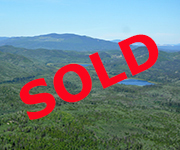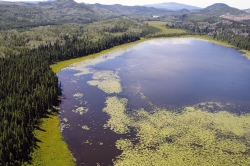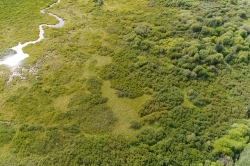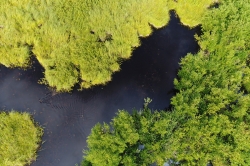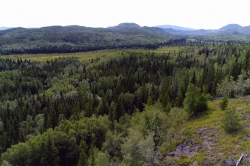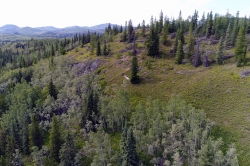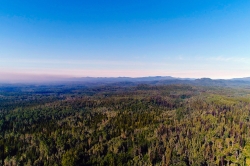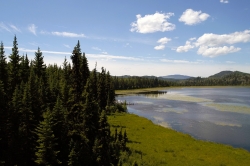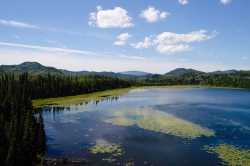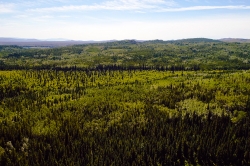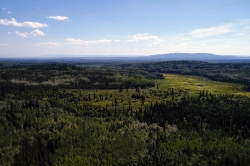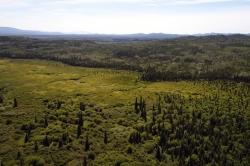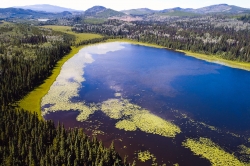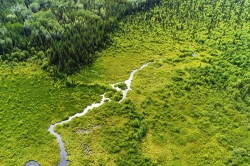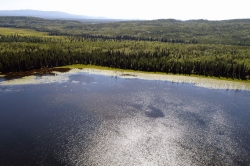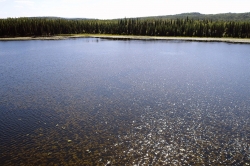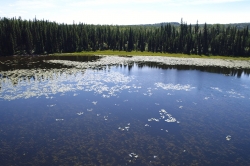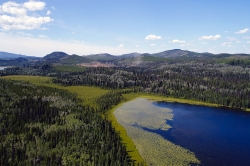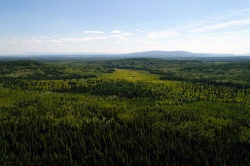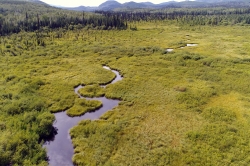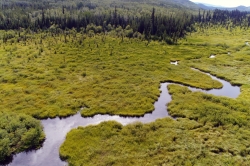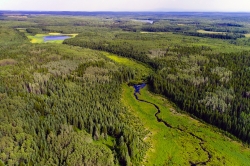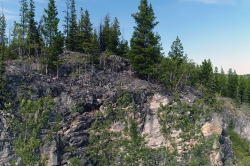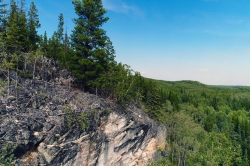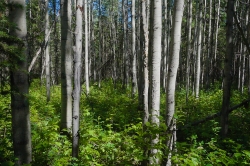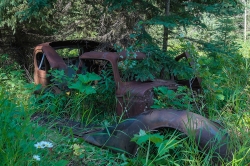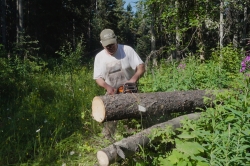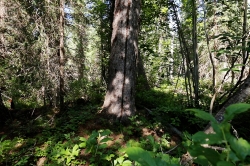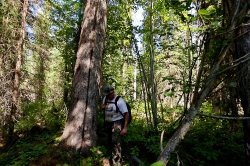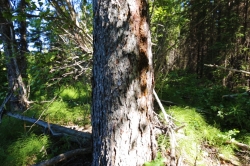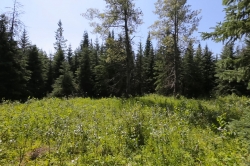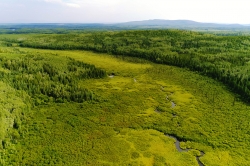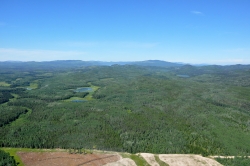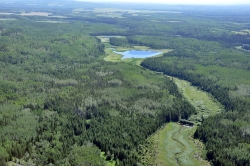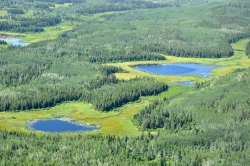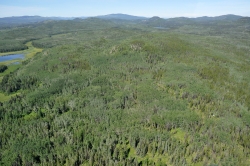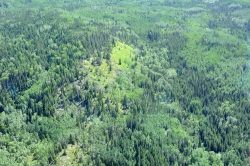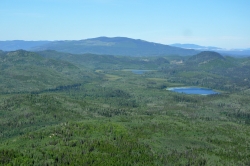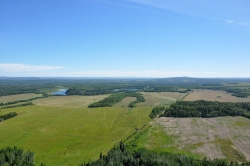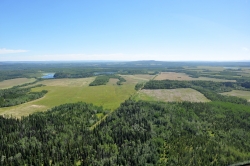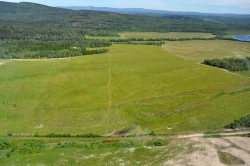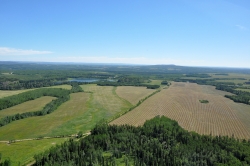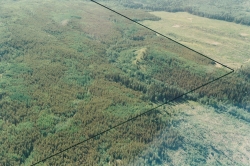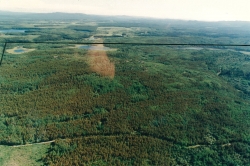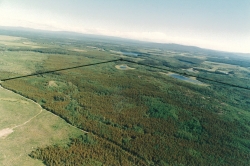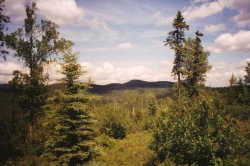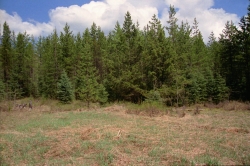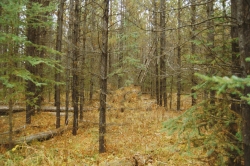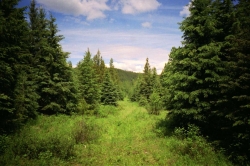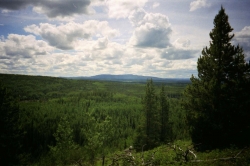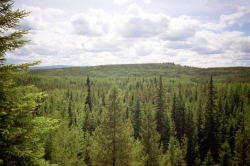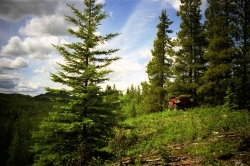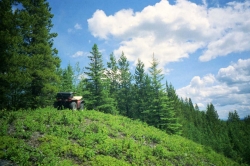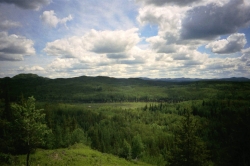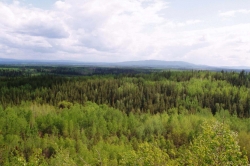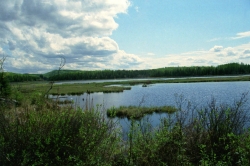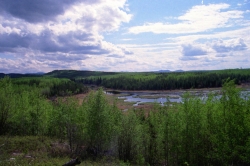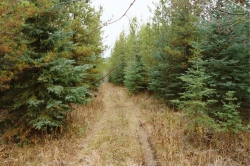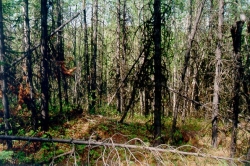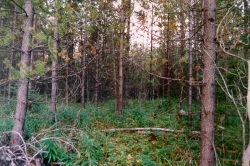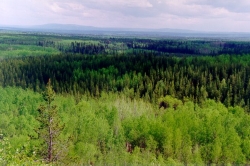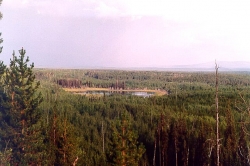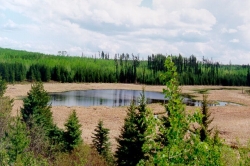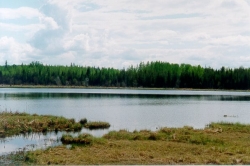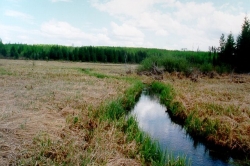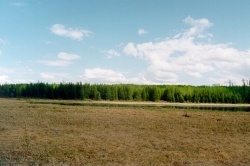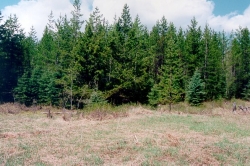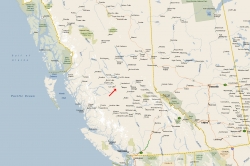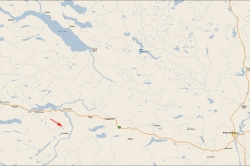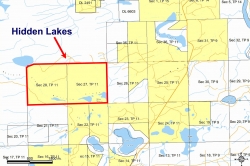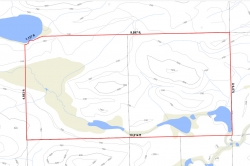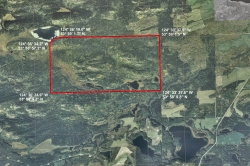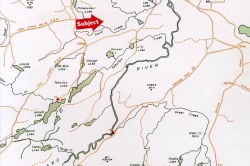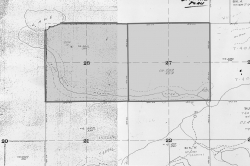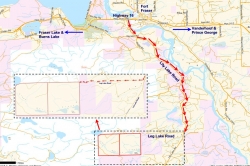Hidden Lakes
| Listing Number: | PG 42A & PG 42B |
|---|---|
| Size: | PG 42A – 640 Acres Total: 1274 Acres |
| Map Reference: | 93F |
| Price: | SOLD |
| Legal: | PG 42A – Section 27, Township 11, Range 04, Land District 13 |
| Description: | This 1,274 acre parcel of land is mostly treed in small pine with scattered spruce throughout. (see timber assessment below) There are two private lakes located in the southeast corner one of, which is fairly small. Small meadows surround both of these lakes. The northwest boundary touches a third lake. A creek runs through the lakes from east to west. The creek continues on along the south boundary then intersects the west boundary flowing west into a small lake two miles west. The contour of the property is a mixed terrain making it very desirable. Most of the property is fairly flat but there are some cliffs near the center of the property, which offer an unbelievable view of the creek and valley below. There are some small meadows near the northeast part of the property and some larger meadows near the northwest part of the property. There are a number of old roads through the property. One old road along the north boundary, which leads to the third lake in the northwest corner and a branch from this old road lead to some cliffs, near the center. There is also an old road from the northeast corner down to the small private lake in the southeast corner. Timber Assessment completed by Avison Management in July 2013. The property consists of a mixture of Pine, Spruce and Aspen. Gross Volume: 29,065 m³ – July 2013 The cruise report indicates a substantial amount of this timber is still immature but is growing significantly so the value will continue to go up. It is suggested to hold the timber to receive maximum profit due to the combination of anticipated low supply plus the increase in demand for timber in the emerging markets. Take a Tour of Hidden Lakes Here |
| Location: | The property is located approximately 48 km (30 miles) due west of Vanderhoof in central British Columbia. Vanderhoof is the geographical centre of British Columbia. |
| Access: | Please call NIHO before heading out to view the property. From Prince George go west for 97 km (60 miles) on Highway 16 to Vanderhoof. Then go 36 km to Fort Fraser and then 1.6km (1 mile) west across the Nechako River bridge and turn left on Lily Lake Road. Travel down the Lily Lake Road at 0.9 km you will see a farm on both sides of the road and a lake on the right (west) hand side of the road. At 11.2 km turn right (west) on a dirt road continue for 1.7 km and you will come to a junction. There is a road straight-ahead with a fence and gate and a road bearing to the right. This gate may be locked, please contact NIHO to arrange further access. Continue straight ahead and open the gate and at approximately 0.8km (1/2 mile) you will to come to the northeast corner of Prince George 42A. From here continue for approximately 1.6 km and you will come to the northeast corner of Prince George 42B. The nearby Vanderhoof Airport (CAU4) has an asphalt runway, runway lighting, GPS, an automated weather station, and an aircraft tracking system, and can accommodate most planes with an airstrip length of 1,530m (5,019 ft). Prince George Airport is the regional airport for Northern B.C., and is expected to play a key role in the economic development of the area. The airport has undergone a major expansion, renovating its runways and international cargo plane fuelling capacity. The airport can accept 747 airplane landings, and has an International Customs and Canada Border Service area for international charter flights. |
| Recreation: | This 1274 acre private parcel is a natural habitat for both moose and deer. Moose have been seen in the meadows by the lake and deer have been spotted in the cliffs near the center of the property. This area is popular with local residents and tourists alike, due to the rare combination of natural, unspoiled beauty and the many and varied year round recreational activities available. The fishing and hunting resources attract sportsmen from all over North America. Within a 60 mile radius of Vanderhoof, there are numerous lakes and rivers and many of these lakes offer rainbow trout fishing where you can catch your limit within less than an hour by fly fishing or casting. Moose and deer are very prevalent throughout this area. Activities vary from hiking, camping, boating, canoeing, golfing, horseback riding and water-skiing in the summer to cross country skiing, curling, skating and snowmobiling in the winter. The town of Vanderhoof is known for hosting major year round events, such as Wild West Week, the Hootersville Hoot, Vanderhoof Airshow, Nechako Valley Exhibition, and Slow-Pitch Tournaments. Hockey, curling, figure skating, and ringette competitions and tournaments are held all winter. Community badminton, volleyball, basketball and indoor soccer take place throughout the winter season. For those looking to hit the links, the Omineca Holf Course is an 18 hole course open from April to October. Murray Ridge Ski Hill is located 60 km away and Vanderhoof residents can enjoy downhill skiing throughout the winter. The Migratory Bird Sanctuary at Riverside park in Vanderhoof, is one of the major migratory stops for Canada Geese, Trumpeter Swans, Northern Pintails, Caspian Turns and White Pelicans – a must see for watchers and photographers, especially in the spring and fall. Just south of Vanderhoof is “Big River Country”, with intricate networks of logging roads providing access to the hundreds of lakes, forests, creeks and rivers waiting to be explored. Activities vary from hiking, camping, boating, canoeing, golfing, horseback riding and water-skiing in the summer to cross country skiing, curling, skating and snowmobiling in the winter. 60 km away is Murray Ridge Ski Hill, which boasts the longest T-bar in North America. There is over 30 km of major alpine runs, 20 km of groomed & track set cross country ski trails, and a 3.7 lighted loop for night skiing. FISHING: Nulki Lake is 8 km (5 miles) long (4,093 acres) and Tachick Lake is 13 km (8 miles) long (5,439 acres). Both are renowned for their excellent fishing and many fishing derbies are held on these lakes. Trout up to 4 lbs. have been caught in Nulki Lake and up to 7 lbs. in Tachick Lake, both in summer and in winter (ice fishing). The Nulki/Tachick Lakes have been for many years recognized as one of the most productive small recreational fisheries in the Vanderhoof area. In the past 15 years a number of projects, generally funded under the Habitat Conservation Fund, have sought to maintain and enhance natural rainbow trout production and recruitment into Nulki Lake. One of the truly unique aspects of the fisheries resource associated with the Nulki/Tachick watershed is the presence of a falls on the lower portion of Corkscrew Creek. These falls are readily passable by rainbow trout, but not coarse fish. As a result the portions of Corkscrew Creek upstream of the falls are occupied exclusively by rainbow trout. Ootsa Lake, approximately 72 km (45 miles) south of Nulki Ranch is part of the Nechako Reservoir and northern boundary of Tweedsmuir Provincial Park. It is a beautiful, large lake, which offers some of the best boating in the province of British Columbia. This huge reservoir links together many lakes including Tahtsa, Whitesail and Natalkuz. These waters can yield spectacular results for large Rainbow and giant Lake Char. Stuart Lake, is the seventh largest in the province (more than 90 kilometers long and up to 13 kilometers wide). It is a favourite fishing lake, not only for the locals but for fisherman from all over British Columbia, Alberta and the United States who come to travel the Stuart / Trembleur / Takla Lake system. Stuart Lake is accessed from the town of Fort St. James 62 km (39 miles) north of Vanderhoof. The Stuart/Trembleur/Takla chain of lakes is one of the most beautiful and exciting in British Columbia. Stuart Lake has many large, beautiful, sandy beaches along its expansive shoreline. It is both a summer and winter recreational area, with a large number of cabins scattered around the lake, mainly at the southeast end at Sowchea Bay. Sowchea Bay and Colony Point have a large number of recreational residences and a few resorts, and many beaches. A person can travel up the Tachie to Trembleur Lake, up the Middle River to Takla Lake, to the Driftwood River, an unspoiled waterway of some 175 miles (281 kilometers). Lake trout to 9.3 lbs., rainbow trout to 5 lbs. and kokanee averaging 1.1 lbs. are resident in Stuart Lake. |
| Services: | None |
| Area Data: | The surrounding area consists mostly of small cattle ranches running from 100-300 head cattle on a cow/calf operation. Vanderhoof (pop.4,480) is a historic ranching and farming community, and is located at the junction of Highway #16 and Highway #27 at the geographical center of British Columbia. Forestry is the number one industry, followed by ranching and farming. Vanderhoof is in a rich, fertile valley known for its cattle ranches and dairy farms with agriculture as the second largest industry in the region. There is also a growing industry in horticultural production. Mining is growing in importance, with a number of mines being developed in the area. Vanderhoof is a main service centre with several government offices, RCMP detachment, schools, hospital, medical clinic, shopping centre, 18 restaurants, 5 hotels/motel, theatre, bowling alley and golf course. The area is served by rail and air (land and float planes). The Vanderhoof Airport has an asphalt runway, runway lighting, GPS, an automated weather station, and an aircraft tracking system, and can accommodate most planes. The Nechako river, which joins the Fraser river at Prince George, runs along the north edge of Vanderhoof. There are a number of very nice residences along the river whose owners have both boats and floatplanes. From this river, you can go on waterways for over 200 kilometers, up rivers and lakes. The people of Vanderhoof are low keyed, easygoing people who are mostly hobby farmers with horses and enjoy the outdoors fishing and hunting. |
| History: | The Carrier Indians pioneered the land in this area long before the first white man arrived in, what is now known as, Vanderhoof. An ancient Indian village known as Chinlac lies just a few miles east of Vanderhoof on the junction of the Nechako and Stuart Rivers. Simon Fraser’s diary relates that he was the first white man to trade with the people of Chinlac. After the fur traders came the packers, miners, telegraph operators, surveyors and finally, settlers looking for their free land of the frontier. Early settlers came in from the south, over the western end of the Telegraph Trail. They traveled up the west coast to Prince Rupert where they boarded river steamers to take them to Hazleton; then they trekked along the Trail to Fort Fraser. Those bound for Fort St. James branched off and followed the pack trail between the two Hudson’s Bay Forts; other continued along the focal point of the Nechako Valley. The telegraph line was erected in the early days with the object of forming an overland connection between America and Europe. The Telegraph Trail followed the line from one end of British Columbia to the other and since it was the only trail into the country, it was also the main artery of travel. Many of the men who had been employed on the telegraph line remained in the north, trading, trapping and prospecting for gold. In 1906, the Village of Vanderhoof was only a survey line in the wilderness to mark the location of the planned railway. When the last spike was driven on April 7, 1914, it started a race for the land. The Grand Trunk Pacific Development Company offered cheap land and had one of their employees,Mr. Herbert Vanderhoof,lay out the townsite. Vanderhoof is Dutch for “of the farm” which was very appropriate, since it was the first agricultural settlement in the province. The town grew, and in 1926, the Village of Vanderhoof was born. With the arrival of World War II, many young men left, and Vanderhoof came to a standstill. But, with the rise of lumber prices, and the arrival of new people in the late 1940’s, it started to grow again. The next boost to the population and the economy came with the construction of Kenny Dam in the early 1950’s. At the peak of its construction it employed 1500 men, and a number of them stayed in the area after the dam was built. The next expansion period came with a large influx of American immigrants in the 1960’s, and since that time Vanderhoof has enjoyed steady growth. |
| Vegetation: | The property consists of a mixture of Pine, Spruce and Aspen. |
| Boundaries: | Surveyed by J.H. Gray in October, 1908. A road marks the north boundary. |
| Taxes: | PG 42A: $962.47 Total: $1644.73 (2017)
|
| Zoning: | RR 1 (Rural Resource). This property is not within the ALR |
| Sold Date: | 06/15/18 |
